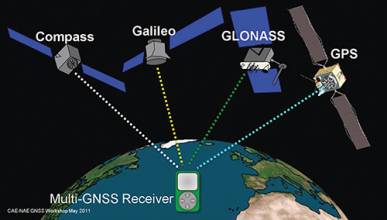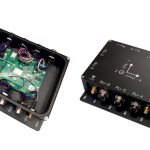Contemporary times have seen an increase in the number of navigation satellites across various geographical regions. In order to ensure that all these satellite systems work together to optimize the positioning, navigation, and timing (PNT) of users on or near the Earth’s surface there is need for inter-cooperation and inter-operability of the systems.
Contemporary times have seen an increase in the number of navigation satellites across various geographical regions. In order to ensure that all these satellite systems work together to optimize the positioning, navigation, and timing (PNT) of users on or near the Earth’s surface there is need for inter-cooperation and inter-operability of the systems.
The International GNSS Monitoring & Assessment Service (iGMAS) was developed by China to monitor the nation’s BeiDou/Compass satellites and ensure precise orbit corrections of the systems so as to improve signal availability, reliability, precision, and accuracy. The International GNSS Service (IGS) has been providing such functions for over 20 years, and regionally the Japan Aerospace Exploration Agency (JAXA) is deploying the Multi-GNSS Monitoring Network (MGM-Net) to provide precise orbit parameters for that nation’s navigation systems.
This article looks at the various multi-GNSS monitoring systems to highlight their major functions while emphasizing the need of international cooperation such that the availability of more satellites in orbit can lead to optimized (centimeter-level) accuracy globally, improved precision, and reliable integrity of the navigation data for the global user.
Going by recent trends, in the near future Asia and the Oceania region will have at their disposal at least a 100 GNSS satellites visible at any time. This should translate into the availability of highly accurate and reliable navigation data with very good integrity, resulting in an environment where on-the-go centimeter level accuracy can be achieved across a vast range of PNT applications. However, this can be realized only through international cooperation of the various countries in these regions.
A cornerstone of achieving such accuracy is precise orbit determination (POD) of GNSS satellites, which forms the basis for precise positioning and timing on the ground. Improving the accuracy of the orbits helps optimize the performance of the entire navigation system. This article discusses various initiatives that have established wide-ranging monitoring networks to track and calculate the POD of satellites from multiple GNSS systems.
iGMAS
In 2011 during the sixth meeting of the International Committee on GNSS (ICG-6), in Tokyo, Japan, a subgroup chaired by Xurong Dong (and co-chaired by Satoshi Kogure from Japan) discussed the International GNSS Monitoring & Assessment Service (iGMAS) and the BeiDou/GNSS Application Demonstration and Experience Campaign (BADEC). The discussion highlighted how these two initiatives could capitalize on the performance, compatibility, and interoperability of GNSS open services while leveraging extensive international cooperation. This led to the formation of the international GNSS monitoring assessment (iGMA) subgroup at ICG-7 hosted by China in November 2012.
Clearly a multi-GNSS environment is preferred due to its obvious advantages of having more satellites in the sky, which thereby enhances robustness, accuracy, and availability.
So what exactly is the iGMAS and how is the different form other GNSS systems like the International GNSS Service (IGS)?
With the introduction of iGMA and also the development of the BeiDou Navigation Satellite System (BDS), China developed the iGMAS to support activities for iGMA. Therefore, the objective of iGMAS is to provide the basic BDS products (orbit, clock, Earth rotation parameters, coordinates, ionosphere, troposphere, differential code biases and integrity) and monitor constellation status, quality of navigation signals, and so forth. Moreover, iGMAS will monitor the inter-system bias, GNSS time difference, and other offsets of BDS from GPS/GLONASS/Galileo.
The framework of iGMAS as proposed in 2012 consists of data monitoring and collecting, data transmit-ting, data storing, data analyzing, and information release. (For details, see the paper by W. Jiao et alia listed in Additional Resources near the end of this article.) All these components work together to monitor and assess GNSS open services (OS) worldwide. Figure 1 illustrates these components in the form of a framework architecture.
By the end of 2012, China had launched 16 BeiDou-2 navigation satellites that include 6 GEOs, 5 IGSOs and 5 MEO [21] and began to provide PNT services for Asia-Pacific region. For effective provision of services such as GNSS performance monitoring, promote service assurance, improve service performance, and ensure the interoperability of OS signals for four systems -GPS/GLONASS/Galileo/BDS A more robust and working architecture was proposed in a presentation by Z. Zhang et alia at a meeting of the Shanghai Astronomical Observatory, Chinese Academy of Sciences (CAS) in 2015, as depicted in Figure 2.
The iGMAS includes the following elements: a tracking stations network (TS), operational center (OC), data center (DC), analysis center (AC), combination center (CC), and monitoring and assessment center (MAC). Core iGMAS products include precise satellite orbit and clock, tracking station coordinates, and receiver clock, zenith total delay (ZTD), Earth orientation parameters (EOPs), global statistical integrity, and ionospheric maps.
The Beijing Aerospace Control Center (BACC) is responsible for operation and maintenance the iGMAS Analysis Center (BAC) and produces the precision products for users with equivalent accuracy as well-known institutes such as IGS and the Center for Orbit Determination in Europe (CODE).
With regard to multi-GNSS processing, BAC implements combined processing capability for the four GNSS systems based on knowledge of the Earth Parameter and Orbit determination System in Real-Time (EPOS and EPOS-RT) software package. Multi-GNSS precise products including orbit and clock, ZTD, EOPs, global statistical integrity, and an ionospheric map.
THE IGS
Since 1994 the International GNSS Service has been releasing many high-precision products, including the global GNSS tracking station coordinates, velocity fields, and ERPs. A voluntary federation of over 200 self-funding agencies, universities, and research institutions in more than 100 countries, the IGS draws on tracking data from more than 400 worldwide reference stations. In addition to providing high-accuracy GPS satellite orbit and clock data, the IGS provides similar GLONASS products as well as GPS and GLONASS raw measurements and related information.
Figure 3 illustrates the distribution of real-time tracking stations in the IGS network, which is currently made up of approximately 130 globally distributed stations maintained by a wide variety of local and regional operators. These stations deliver one-hertz data to the real-time data centers with typical latencies of three seconds or less.
IGS AC products demonstrate the importance of fusing multi-source spatial geodetic data to realize the International Terrestrial Reference Frame (ITRF) produced by the International Earth Reference Service (IERS). The POD of GPS is well advanced at IGS with the service’s final orbit products for GPS satellites reaching an accuracy of less than 2.5 centimeters. In short, the mission of IGS is to provide the highest quality GNSS data, products, and services in support of Earth observation and research, PNT, the terrestrial reference frame, Earth rotation, and other applications that benefit society. Appropriately enough then, IGS co-chairs the iGMAS initiative.
The IGS architecture aims at creating a more robust data network and minimizing the possibility of single-point failures by ensuring that two separate data centers receive real-time data streams from the tracking stations. Similarly, reference station data from more than one data center are made available to analysis centers.
Upon the successful reception of the GNSS data at the analysis centers, processing of the data takes place and is then transmitted to the combination centers; afterwards the final product streams are broadcasted to the users.
A core task for the IGS is the estimation of GNSS reference station coordinates, which is at the heart of realizing and maintaining the ITRF using IGS data products. Another crucial mission is the determination of ERPs because they are essential physical parameters in the conversion of celestial coordinate system and Earth-centered coordinate system. ERPs are also crucial data for satellite precise orbit determination, high-accuracy positioning, and navigation. In order to facilitate and combine the AC products, IGS proposed the SINEX (Software INdependent EXchange) format file.
In the Asian region, the Japan Aerospace Exploration Agency (JAXA) is deploying the Multi-GNSS Monitoring Network (MGM-Net) with about 60 sites globally. Figure 4 shows the MGM-Net stations, including data-sharing centers from cooperating organizations. MGM-Net’s mission includes:
- improving the accuracy of precise orbit determination (POD) for Japan’s Quasi-Zenith Satellite System (QZSS), and hence improving the accuracy of precise point positioning (PPP) applications.
- performing precise orbit determination for GNSS systems besides GPS and QZSS
- broadcasting error correction and integrity information from QZSS to support the multi-GNSS demonstration campaign.
Figure 5 shows the complimentary aspects of the iGMAS, IGS, and MGM net as outlined in the presentation by X. Dong (See Additional Resources).
For an efficient service delivery, worldwide coverage with redundant stations is important to boost the reliability of data available from different geographical locations. However, this objective has been a challenge in some areas of the globe, especially in the southern Pacific where IGS station operators need to comply with a minimum set of standards and encouraged to adopt best practices for real-time operations. One of the core principles of the IGS is the open data policy for both raw and tracking data as well as the resulting IGS products. An IGS initiative that reflected the multi-GNSS era was the formation of a global multi-GNSS test named the Multi-GNSS EXperiment (MGEX), which provided a crucial platform to promote the application of multiple GNSS systems. Figure 6 shows the distribution of IGS stations participating in MGEX.
Over a period of four years, MGEX tracked, collated, and analyzed all available GNSS signals. This included signals from the BeiDou, Galileo, QZSS, and the Navigation with Indian Constellation (NAVIC, also known as the Indian Regional Navigation Satellite System or IRNSS) satellites, as well as from modernized GPS and GLONASS spacecraft and any space-based augmentation system (SBAS) of interest.
As a result of MGEX’s success, IGS decided in early 2016 to terminate the experimental phase of MGEX and to pursue IGS multi-GNSS activities as a pilot project, retaining the name MGEX for the project.
Both iGMAS and IGS incorporate satellite laser ranging (SLR) observations to provide independent validation of orbits derived using the microwave measurements of GNSS signals. With BDS anticipated to be global by 2020, in developing the iGMAS centers SLR observations will become very helpful when the constellation is completed, especially for space geodesy applications. SLR allows for an independent accurate way to determine the range from ground stations to satellites without carrier phase ambiguities caused by GNSS signal propagation through the atmosphere.
SLR retro-reflectors are already present on some GPS satellites (GPS 35, 36), all GLONASS satellites, multiple BeiDou satellites (M1, M3, G1, I3 and I5) as well as Galileo satellites (101, 102, 103, 104 and 201). (For details, see the article by J. Sun et alia in Additional Resources.) Indeed, retro-reflectors installed on both the satellite and ground station are crucial component in the SLR system used for precise orbit determination.
In summary, a multi-GNSS environment increases the availability of satellites viewed by receivers, enables improved accuracy often to centimeter-level (with augmentation), and increases reliability so that signals are more resistant to interference and spoofing. Nonetheless, drawbacks exist for use of multi-GNSS methods. Inter-system interference where GNSS broadcast navigation signals tend to overlap in frequency bands and the advanced but complex signal structures in multiple frequency bands challenges receiver designs with their computational requirements.
Tracking Analysis of iGMAS and Other Systems
The article by H. Cui et alia provides a good comparison of iGMAS with other multi-GNSS systems during a 2013 campaign that combined GPS, GLONASS, BDS, and Galileo observations. The article describes the processing activities of the iGMAS Analysis Center (BAC) at the Beijing Aerospace Control Center (BACC) and compares the results against products from other institutes. This involved analyzing the effects on orbit and clock precision by comparing multi-system processing with single-system processing and evaluating the improvement in PPP.
Although multi-GNSS precise products includes additional elements such as ZTDs, EOPs and so forth, the focus here is on the combined orbit and clock parameters. The research strategy involved using the observation data from a network of multi-GNSS capable receivers from the MGEX tracking network and a regional BDS station network operated by China during 14 days in 2013. Figure 7 shows the 17 tracking stations used in the campaign.
The BAC researchers carried out a joint orbit determination of GPS and GLONASS/BDS/Galileo, first fixing the coordinate of station, receiver clock and tropospheric parameters using GPS precise ephemeris and clock data, and subsequently determining the inter-system bias (ISB) between GPS and GLONASS/BDS/Galileo.
Figure 8 shows sample results of the BACC campaign and present the ISBs between of GPS and BDS for all stations in which the ISBs on different days (indicated in the boxed legend) reveal the same change trend.
Figure 9 shows the average PPP accuracy of various systems using GPS one-day static PPP coordinates as a reference and reflects the better PPP performance possible with multi-GNSS techniques.
The preliminary research indicates that the BACC processing strategies using iGMAS and other multi-GNSS monitoring resources were practicable and provide a good basis for multi-GNSS data analysis and other GNSS-based scientific research in the future.
Conclusion
As rightfully noted by Tim Springer, a member of the IGS Multi-GNSS Working Group, the IGS has more than 20 years’ experience in delivery of high-quality products. IGS is committed to working with various GNSS service providers and organizations that have established regional global tracking networks such as iGMAS. The cooperation will be such that IGS infrastructure will be used to contribute to the establishment of services by the iGMAS.
Acknowledgment
Prof. Yang Dongkai, for his superb supervision and guidance in making this paper possible. I thank the management and staff of National Space Research and Development Agency (NARSDA) and the African Regional Center for Space Science and Technology Education-English (ARCSSTE-E).
Additional Resources
1. Caissy, M., and L. Agrotis, G. Weber, M. Hernandez-Pajares, and U. Hugentobler, “The International GNSS Real-Time Service,” GPS World, June 2012
2. Center for Orbit Determination in Europe, Products from the CODE Analysis Center
3. Cui, H., and G. Tang, S. Hu, B. Song, H. Liu, J. Sun, P. Zhang, C. Li, M. Ge, and C. Han, “Multi-GNSS Processing Combining GPS, GLONASS, BDS and Galileo Observations,” China Satellite Navigation Conference (CSNC) 2014 Proceedings: Volume III, Springer Science & Business Media
4. Curtin University, GNSS Research Center, “Multi-GNSS Monitoring Network (MGM-Net)”
5. Dong, X., “International GNSS Monitoring & Assessment Service for OS (iGMAS),” Presentation on iGMAS for Working Group A, International Committee on GNSS, Sixth Meeting (ICG-6), Tokyo, Japan, September, 2011
6. Hothem, L., “Multi GNSS Current Status and Future,” Multi GNSS Environment IAG/FIG Commission 5/ICG Technical Seminar, “Reference Frame in Practice,” Rome, Italy May 4–5, 2012. Accessed here
7. Hugentobler, U., and T. Springer and R. Dach, “IGS Activities on GLONASS,” GGOS-RAS Meeting, Vienna, April 9, 2013
8. International Committee on GNSS, Sixth Meeting Workshop Summary and Reports Catalogue, Tokyo, Japan, 2011
9. Jiao, W., and Q. Ding, J. Li, X. Lu, and L. Feng, “Monitoring and Assessment of GNSS Open Services,” Global Navigation Satellite Systems: Report of a Joint Workshop of the National Academy of Engineering and the Chinese Academy of Engineering, 2012.
10. Kogure, S., “Report on a Multi-GNSS Demonstration Project in the Asia/Oceania Region,” ICG-10, Boulder, Colorado USA
11. Li, M., and L. Qu, Q. Zhao, J. Guo, X. Su, and X. Li, “Precise Point Positioning with the BeiDou Navigation Satellite System,” Sensors, Vol. 14, No. 1, 927-943; doi:10.3390/s140100927, 2014
12. Li, M., and T. Xu, “Research on the Combination of IGS Analysis-Center Solution for Station Coordinates and ERPs,” China Satellite Navigation Conference (CSNC) 2014 Proceedings: Volume III, Springer Science & Business Media
13. Lollock, R., and T. Powell and T. Stansell, “The Interchangeability Problem: Signals, Coordinate Frames, and Time,” Global Navigation Satellite Systems: Report of a Joint Workshop of the National Academy of Engineering and the Chinese Academy of Engineering, 2012
14. Montenbruck, O., and P, Steigenberger, R. Khachikyan, G. Weber, R. Langley, L. Mervart, and U. Hugentobler. “IGS-MGEX, Preparing the ground for Multi-Constellation GNSS Science,” Inside GNSS, January/February 2014
15. Rizos, C., “Preparing for the Next Generation: The Multi-GNSS Asia Demonstration Campaign,” GPS World, December 2011
16. Satellite Based Augmentation System Review, Australia, May 2011.
17. Springer, T., “Multi-GNSS Monitoring: Practice Versus Theory,” Inside GNSS, January/February, 2014
18. Sun, J., and J, Liu, S. Fan, and X. Lu, “New results of Multi-GNSS Orbits Validation Based on SLR Observation,” China satellite Navigation Conference (CSNC), 2015, Volume III, Chapter 13, Springer Science & Business Media
19. Ta, T. H., and D. M. Truong, T. T. T. Nguyen, T. D. Nguyen, H. T. Tran, G. Belforte, “Multi-GNSS Positioning Campaign in South-East Asia,” Coordinates, 2013
20. Zeng, G., and B. Gong, J. Wang, J. Li, and J. Zhu, “BeiDou/GPS Indirect Fusion Precision Orbit Determination,” China Satellite Navigation Conference (CSNC) 2014 Proceedings: Volume III, Springer Science & Business Media
21. Zhang, Z., and F., S. Song J. Chen, and B. Wu, “Status and Plans for the Chinese Space Geodesy Network (VLBI, SLR, GNSS),” 2015 Astronomical Observatory (SHAO), Chinese Academy of Sciences (CAS), 2015






